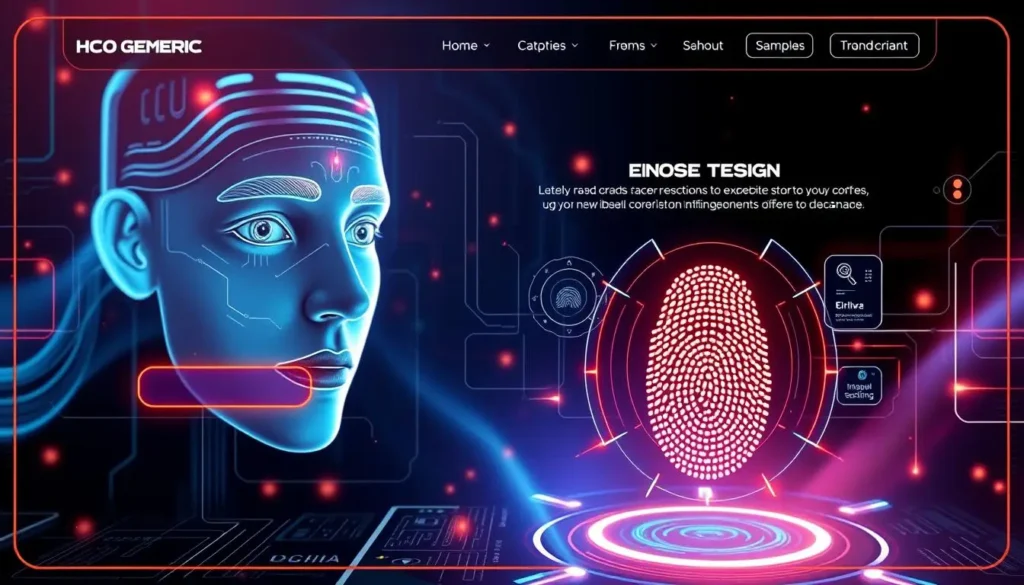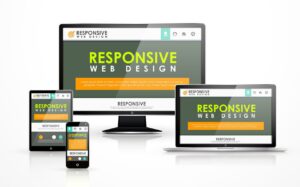Web design is changing fast. It’s now using biometric tech to make digital interfaces better. This new way makes web design more personal and bright.
This new idea is not just for anyone. It’s for each person. It uses eye tracking and voice to make websites fit you better. This makes your online time more memorable.
As we mix more humans and machines, websites will get even better. They will understand you better and feel more like you. Get ready for a new way of using the web that’s all about you.
Biometric-driven design in web design: A Paradigm Shift in Web Development
The digital world is changing fast. Web design is getting a big update. This update comes from a biometric-driven design. This new way uses biometric tech. It makes online interactions more personal and easy to use.
For a more foundational overview, explore what web design is.
i. Defining Biometric-Driven User Interfaces
Biometric user interfaces know and act on our body signs. They see our faces and eyes and hear our voices. This makes using the web feel natural and smooth.
ii. The Evolution from Traditional to Biometric Web Design
Old web design focused on looks and function. But biometric design goes deeper. It makes the web feel more like it’s made just for you.
It uses your biometric data to change and improve the web experience. This makes your online time more fun and personal.
iii. Key Components of Biometric Integration
Biometric tech in web design includes:
- Facial recognition for personalized content and authentication
- Eye tracking to monitor user attention and engagement
- Voice recognition for natural language interactions
- Emotion detection to gauge user sentiment and tailor the experience
With these features, web designers can make sites that get to know you. This leads to a better and more enjoyable online experience.
Get in Touch with Our Team

Biometric-Driven Design Future Web Design: Transforming User Experiences
The future of web design is changing fast. It’s all about biometric-driven technologies. These new tools are making digital interfaces better and more personal. Web designers can now create sites that talk to each user. They use biometric data to make sites more fun and easy to use. This means every user gets a site that fits just right.
The biometric design makes sites feel more personal. It looks at things like facial expressions and heart rate. This way, sites can change to match how you feel and what you like. This personal touch makes users happier. It also helps brands connect better with their audience. It’s a win-win for everyone.
The biometric design also makes sites better to use. It watches how you interact and adjusts the site to fit your needs. This makes sites more straightforward to use and more fun. With this data, sites can be more intuitive. This means users stay longer and do more. It’s suitable for everyone involved.
This shift aligns with broader principles of intuitive web experiences in life science web design and development. Explore more here.
| Biometric-Driven Design Features | Benefits to User Experiences |
| Facial Recognition | Personalized content recommendations, emotion-based interface adjustments |
| Eye Tracking | Optimized layout and navigation, enhanced visual engagement |
| Gesture Control | Intuitive interactions, seamless navigation, and reduced cognitive load |
| Multimodal Interfaces | Seamless cross-platform integration, context-aware experiences |
As we move forward, biometric design will be key. It lets designers make sites that connect with people. This is the future of web design.
The Rise of Emotional Design and Affective Computing
Web design is changing fast. It’s because of emotional design and new tech. Affective computing helps us make digital things that feel real to users.
i. Measuring Emotional Responses in Real-Time
Now, websites can help us feel how we feel. They use sensors to see our heart rate and face. This allows designers to make sites better for us.
ii. Implementing Mood-Responsive Interfaces
Designers use affective computing to make sites that change with us. A site might turn blue if we’re feeling calm. Or bright if we’re excited.
iii. Creating Empathetic Digital Experiences
Emotional design and tech make sites that get us. They can tell how we feel and change to match. This makes our online time better and more fun.
| Emotional Design Principles | Biometric Integration | User Behavior Insights |
| Empathy-driven design | Real-time emotion detection | Personalized user journeys |
| Mood-responsive interfaces | Physiological signal analysis | Improved engagement and conversion |
| Intuitive user interactions | Facial expression recognition | Enhanced customer experiences |
Facial Recognition and Personalized User Journeys
The world of web design is changing fast. This is thanks to biometric tech like facial recognition. It’s making user experiences more personal and tailored to each person.
Facial recognition makes things safer and easier. It lets websites know who you are and what you like. This tech can make your online time better and more fun.
- Enhancing Security: Facial recognition is better than passwords. It keeps your info safe and makes logging in easy. Only the right people can get to your stuff.
- Personalized Experiences: Web designers can make sites just for you. They use facial recognition to know what you like. This makes your online time better and more fun.
- Adaptive Interfaces: Sites can change based on how you feel. Facial recognition lets them know if you’re happy or tired. They can make things better for you right away.
As facial recognition gets better, web design will too. Designers will make sites that get to know you. This will change how we use the internet for the better.
Voice Recognition and Natural Language Processing in Web Interfaces
The web design world is changing fast. Voice recognition and natural language processing make it easier for us to use websites. With Google Assistant and others, web designers are making sites more user-friendly.
i. Voice-First Design Principles
Designing for voice means changing how we make websites. We focus on being simple, straightforward, and knowing what’s happening. Sites need to understand what we say and give us answers in a way we can understand.
ii. Multilingual Voice Recognition Systems
Web designers are making sites that work in many languages. This lets more people use websites, no matter where they are from. It’s a big step towards making the web more global.
iii. Voice Commerce Integration
Voice technology is changing online shopping, too. Now, we can buy things by just talking to our devices. This makes shopping easier and more fun, suitable for buyers and sellers.
As more people use voice technology, web designers need to keep up. Using voice recognition and natural language processing, they can make websites that feel like they’re talking to us. This is forever changing how we use the web.
For more on innovative interaction models, check out Websites Aren’t Static.
Adaptive Interfaces and Machine Learning Integration
The web design world is changing fast. Now, we have adaptive interfaces powered by machine learning. These intelligent systems learn and adjust to fit what each user likes. This makes web experiences more personal and easy to use.
Adaptive interfaces use machine learning to change how things look and work. They adjust based on how users act, their devices, and where they are. This makes the experience smooth and fits what each person needs.
At the heart of these interfaces are artificial intelligence and machine learning. These innovative tools watch how users act and change the site to match their likes. As users use the site, it gets better at guessing what they want.
Web designers can make sites that connect with users by using these tools. This makes sites more engaging, helps more people take action, and keeps users coming back. It’s a big step forward in how we use the internet.
The web is improving, and adaptive interfaces and machine learning are key. Web designers can make sites that look great and work well for everyone. This makes the web a better place for all of us.
To see how adaptation drives web functionality, explore what Scaffolding Means in web design.
Get in Touch with Our Team

Security and Privacy Considerations in Biometric Web Design
Biometric web design is getting more popular. But, we must focus on keeping data safe and private. Web designers need to follow strict rules to use these new techs right.
i. Data Protection Protocols
Keeping user biometric data safe is very important. Web designers must use strong security measures. This means using encryption and maintaining data in safe places.
ii. User Consent and Control
It’s key to be open and let users control their data. Web designers should make it clear how data is used. Giving users control over their data helps build trust.
iii. Regulatory Compliance Standards
Web designers must follow strict rules for biometric data. Laws like GDPR and HIPAA are fundamental. They help keep user data safe and legal.
| Regulation | Key Requirements |
| GDPR | Explicit consent, data minimization, purpose limitation, and data subject rights |
| HIPAA | Secure storage, access control, and breach notification for healthcare-related biometric data |
By focusing on security and privacy, web designers can gain user trust. They also make sure they follow all the rules.
Accessibility and Inclusive Design in Biometric Systems
Web design is changing fast. It now uses biometric technologies. It’s key to make sure these changes help everyone.
Biometric design can change how we use the web. But, we must focus on making it accessible and inclusive. This way, everyone can use it.
i. Embracing Inclusive Design Principles
Inclusive design is more than just following rules. It’s about making things work for everyone. When making biometric interfaces, designers need to think about:
- Seamless integration of alternative input methods for users with limited mobility
- Intuitive and customizable biometric recognition for users with unique physical characteristics
- Clear visual and audio cues to support users with hearing or visual impairments
- Adherence to best practices for cognitive accessibility, ensuring intuitive and stress-free interactions
ii. Ensuring Ethical Data Practices
Using biometric data raises significant privacy and security questions. Web designers must focus on ethical data use. They need to make sure users’ data is safe, and they know how it’s used.
As web design keeps changing, biometric tech is a big deal. By focusing on accessibility and inclusivity, designers can make the web better for everyone.
Multimodal Interfaces and Cross-Platform Integration
The digital world is changing fast. The future of web design will use multimodal interfaces and cross-platform experiences. Web designers will make websites that work well on many devices and platforms.
i. Seamless Device Synchronization
One big thing about cross-platform is syncing data across devices. Biometric tech lets users move quickly between devices. This keeps their experience the same everywhere.
This makes things more convenient. It also makes users feel closer to the digital world.
ii. Context-Aware Applications
Biometric tech also helps make apps that know what’s happening around you. These apps use sensors and intelligent algorithms. They change how they work based on what you need.
This makes your experience more personal and fun. It’s like having a special friend in your digital world.
iii. Universal Design Principles
As more people use biometric tech, we must ensure it’s for everyone. Web designers need to make sure it’s easy for all to use. This means making it work for people with different needs.
By doing this, we make the internet a better place for everyone. It becomes more fair and welcoming for all users.
Conclusion
The future of web design is all about biometric technologies. They make our online experiences better and more personal. This change is making the web a more interactive place for everyone.
Now, websites can feel our emotions and change to match. They use our faces and voices to understand us better. This makes our online time more memorable and fun.
As we go on, web design will keep getting better. It will focus on keeping us safe and ensuring everyone can use it. The web will soon fit just right for you, no matter where you are or what you like.
FAQ
What is biometric-driven design in web development?
The biometric-driven design uses tech like facial recognition and voice scanning. It makes websites more personal and safe for users.
How does biometric-driven design differ from traditional web design approaches?
It focuses on using biometric data to understand users better. This makes websites more personal and adaptable.
What are the key components of biometric integration in web design?
It includes sensors, algorithms, and intelligent systems. These help collect and analyze biometric data in real time.
How can biometric-driven design transform user experiences in the digital world?
It makes websites more intuitive and engaging. Users get personalized content and experiences that feel more real.
How can affective computing and emotional design be integrated into biometric-driven web design?
It uses facial expressions and heart rate to understand emotions. This makes websites more empathetic and responsive.
What role does facial recognition play in biometric-driven web design?
Facial recognition makes websites more secure and personal. It recognizes users and tailors content to their preferences.
How can voice recognition and natural language processing be incorporated into biometric-driven web interfaces?
Voice recognition lets users interact with websites using voice. It supports many languages and makes shopping easier.
What are the key considerations for security and privacy in biometric-driven web design?
It’s important to protect user data and get their consent. This ensures biometric data is used safely and ethically.
How can biometric-driven web design address accessibility and inclusive design?
It offers inclusive experiences for all users. Biometric tech can help those with different abilities by providing personalized options.
What is the role of multimodal interfaces and cross-platform integration in biometric-driven web design?
They make websites work well on all devices. This creates a seamless and immersive experience for users.








